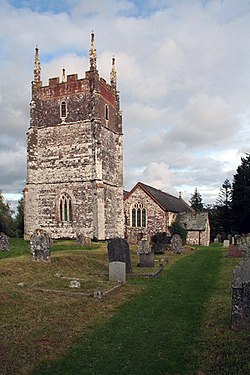Cruwys Morchard
| Cruwys Morchard | |
| Devon | |
|---|---|
 Church of the Holy Cross, Cruwys Morchard | |
| Location | |
| Grid reference: | SS874121 |
| Location: | 50°53’52"N, 3°36’5"W |
| Data | |
| Local Government | |
| Council: | Mid Devon |
Cruwys Morchard is a parish (in both the ecclesiastical and municipal senses) in the midst of Devon, to which is attached barely even a hamlet, but here is a church here and a farmstead, about four to five miles west of Tiverton along the road to Witheridge. The parish covers about 5,765 acre of land, within which stand a number of scattered houses and farms, and three small hamlets, Pennymoor, Way Village and Nomansland.
The church and the manor house are in the centre of the parish. The population at the time of the 2000 census was 461.
The parish takes its name from the Cruwys family who have been Lords of the Manor here since the reign of King John (1199–1216).
History

The manor of Morceth appears twice in the Domesday Book of 1086, with part being held in-chief by William Cheever, the 35th of his 46 Devonshire holdings,[1] and part being held in-chief by Geoffrey de Montbray, Bishop of Coutances, the 73rd of his 99 Devonshire holdings.[2][3] William Cheever's lands later formed the feudal barony of Bradninch from which Cruwys Morchard was later held by the Cruwys family.[4]
Church of Holy Cross
It is believed that a wooden Church existed in Cruwys Morchard from the time of Godfrey de Sowy who was the first Rector in 1262.
The Church of the Holy Cross was built in 1529[5] with a spire on top of the church tower. This, however, was struck by lightning in 1689, and the consequent major fire, which melted the bells, necessitated the rebuilding of the top stage of the tower in brick. It also destroyed painted windows which bore the arms of the Cruwys family. The repairs, which also involved a new roof and new pews, took thirteen years to complete. The windows were replaced with stained glass renderings of the Cruwys arms.
There was also a chapel belonging to Cruwys Morchard House which was the burial place of the Cruwys family but the chapel was destroyed in the days of Oliver Cromwell and it is believed that many family monuments were destroyed at the same time.
Outside links
| ("Wikimedia Commons" has material about Cruwys Morchard) |
- Information on Cruwys Morchard from GENUKI
- Cruwys Morchard Parish
- Cruwys one-name study
- Photograph and story of the Church
- Old postcards of Cruwys Morchard
References
- ↑ Thorn, Caroline & Frank, (eds.) Domesday Book, (Morris, John, gen.ed.) Vol. 9, Devon, Parts 1 & 2, Phillimore Press, Chichester, 1985, chap.19, holdings of William Cheever, 19,35, Morceth
- ↑ Thorn, chap 3,73
- ↑ "Cruwys Morchard - History". Cruwys Morchard Parish Council. 2004. Archived from the original on 14 March 2007. https://web.archive.org/web/20070314041602/http://www.middevon.gov.uk/cruwysmorchard/index.cfm?articleid=964. Retrieved 2007-04-03.
- ↑ Thorn, part 2, 19,35
- ↑ Transcribed by Debbie Kennett (2006). "Letter from George Sharland Cruwys to Frederick Stockdale, 2nd January 1841". GENUKI. http://genuki.cs.ncl.ac.uk/DEV/CruwysMorchard/StockdaleLetter.html. Retrieved 2007-04-03.
